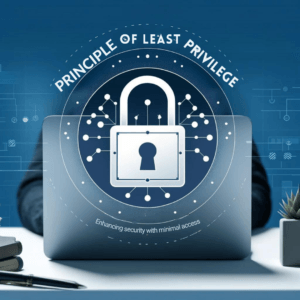What is the Principle of Least Privilege?
Imagine if every employee at your company had the key to every room. Sounds risky, doesn’t it? That’s where the principle of least privilege (PoLP) comes in. It’s a vital concept in cybersecurity. It requires that you grant individuals access only the access needed to perform their job role. This minimizes potential touchpoints for security breaches.

Now, why should this matter to you as a business manager? In practice, enforcing the least privilege can make a difference. It can separate a secure company from one vulnerable to attacks. If an employee’s credentials are compromised, the attacker can only access what the employee could, limiting the damage.
Think of least privilege as a VIP list for your company’s most sensitive areas. Not everyone needs to be on the list. Operating on a need-to-know and need-to-access basis can minimize risk. Moreover, it can keep your company’s data safer. It’s like having a dedicated security guard for each critical asset. Thus, ensuring that only the right people get through at the right time.
Let’s transition from theory to reality in the next section. We will showcase how this principle shields your business against cyber threats. We’ll explore what happens when least privilege works as it should. We will also explore the costly consequences when it doesn’t.
Key Takeaways
- Implement the principle of least privilege to minimize security risks.
- Conduct regular privilege audits and continuous monitoring.
- Use role-based access control to support PoLP.
- Educate your team on the importance of PoLP.
- Integrate PoLP with Zero Trust architecture for enhanced security.
The Direct Impact of Least Privilege on Your Business Security
You know that security is not just a buzzword. Security is the shield that keeps your business safe from unseen threats. The principle of least privilege is a bayonet in the ongoing battle against cyber risks. Adopting this principle can have a DEFINITIVE IMPACT on the integrity and resilience of your business’s digital landscape.
Think of least privilege as giving employees the bare minimum access they need to do their jobs. This isn’t about distrusting your team. Least privilete is about safeguarding from the ripple effects of a potential security breach. By restricting access, you’re building a series of only-the-essential passes into your fortress. Thus, making sure that even if one is compromised, the rest stay secure.
The conversations in boardrooms across the globe echo with instances where adopting least privilege thwarted would-be cyber disasters. In the healthcare sector, for instance, patient data is the lifeblood of trust. Healthcare organizations applying the least privilege have seen noticeable reductions in privacy violations, thus protecting their reputation and saving them from hefty fines.
Financial firms, with their troves of sensitive client information, must heed this principle to avert catastrophic losses. A case in Canadian banking showcased how strict access controls prevented a fraud attempt, saving millions in potential damages. It’s not the size of your business that dictates the need for least privilege; it’s the VALUE of the digital and intellectual property you’re guarding.
Neglecting this principle can come at a high price. The aftermath of a cyberattack often involves more than just financial loss; it can mean a damaged reputation, legal liabilities, and lost customer trust. All of this can be mitigated simply by defining ‘who needs access to what’ and enforcing it without exceptions.
For instance, a healthcare provider uses PoLP. By doing so, they can better protect sensitive patient information from unauthorized access. Thus maintaining trust and avoiding costly violations.
Why Implement the Principle of Least Privilege?
Implementing PoLP has numerous benefits. These include:
- reducing the risk of data breaches
- minimizing the spread of malware,
- ensuring compliance with regulatory requirements.
Endpoint Security: A Crucial Frontier for Enforcing Least Privilege
Understanding endpoint security is essential in today’s landscape of smartphones, laptops, and other devices connecting to your business networks. These points of entry, referred to as ‘endpoints,’ are potential gateways for security threats if not properly managed.
Applying the principle of least privilege (PoLP) to endpoint security involves giving users the minimum level of access necessary to perform their jobs. Why does this matter? It significantly reduces the risk of malware spreading or sensitive data being exposed if a device is compromised.
For effective management, think of endpoint devices as individual employees, each with specific roles. The same way you wouldn’t give all employees a key to every room in the office, devices shouldn’t have open access to all areas of your network.
To start, assess the necessary access levels for different roles within your company. Then, implement access controls that reflect these requirements, ensuring that each device has privileges tailored to its user’s needs.
Remember, adopting least privilege in endpoint security is not a ‘set it and forget it’ task. It requires ongoing administration and monitoring. Regularly review and adjust privileges to adapt to changes within the organization, like role shifts or software updates.
What are the Steps to Implement PoLP?
Implementing PoLP involves several key steps. These include:
- conducting an initial assessment
- developing a detailed implementation plan,
- educating employees about the importance of minimal privilege access
These steps ensure that the principle is effectively part of your organization’s security strate
Initial Assessment and Audit
Start with a comprehensive audit of current access rights. Identify all critical systems and data. Then, determine who currently has access to them. This baseline will help identify any excessive permissions that need to be revoked.
Developing an Implementation Plan
Create a phased implementation plan focusing on the most sensitive assets first. Gradually extend PoLP to other areas, learning and adjusting the approach as needed.
Training and Education
Educate your team about the importance of PoLP. Conduct training sessions to explain how limiting access reduces risks. Also, how it safeguards the organization against potential threats.
What is Privilege Creep?
Privilege creep occurs when users accumulate unnecessary privileges over time. Thus, increasing the risk of unauthorized access. Addressing privilege creep is essential for maintaining effective access control. Moreover, it ensures that the principle of least privilege is upheld. Regular audits and privilege reviews are critical in mitigating this risk.
Causes of Privilege Creep
Privilege creep occurs when users accumulate access rights over time beyond what is necessary for their roles. This often happens due to poor management of access controls and a lack of regular audits. I have seen this happen when someone is granted levels of access for a particular role. In my case, I transitioned from IT (high level of access) to cybersecurity (lower level of access), but there was a period when I filled both roles and it took management and myself to realize that I no longer needed privileged credentials for certain parts of the system.
Impact on Information Security
Privilege creep increases the attack surface, making the organization more vulnerable to internal and external threats. Regular audits and strict enforcement of PoLP can mitigate these risks.
How Does Role-Based Access Control (RBAC) influence PoLP?
Role-Based Access Control (RBAC) supports the principle of least privilege by assigning access based on user roles. Implementing RBAC ensures that users have only the permissions necessary for their job functions, aligning with PoLP principles and enhancing overall information security.
How RBAC Supports PoLP
RBAC allows organizations to assign access based on user roles, ensuring that each user has only the permissions needed for their job. This alignment with PoLP helps maintain strict access control.
Implementing RBAC in Your Organization
Implementing RBAC involves defining roles, assigning appropriate permissions, and regularly reviewing these roles to ensure they align with current job functions.
How do we incorporate PoLP into Endpoint Security
Applying the principle of least privilege to endpoint security is crucial in today’s environment of mobile and remote work. By limiting access on endpoints, organizations can reduce the spread of malware and protect sensitive data. Regularly updating and monitoring endpoint privileges is key to maintaining a strong security posture.
Protecting Endpoints with Minimal Privilege
Endpoints such as laptops and smartphones are common entry points for cyber-attacks. Applying PoLP to these devices ensures that they have only the necessary access, reducing the risk of malware spreading across the network.
How do Auditing and Monitoring Access influence PoLP?
Regular auditing and continuous monitoring of access rights are essential components of maintaining the principle of least privilege. These practices help identify and address unauthorized access, ensuring that privileges are appropriately managed and risks are minimized.
Regular Privilege Audits
Conduct regular audits to review user access rights and ensure they align with PoLP principles. These audits help identify and revoke unnecessary privileges, reducing the risk of unauthorized access.
Continuous Monitoring Strategies
Implement continuous monitoring tools to track access patterns and detect anomalies. This proactive approach helps maintain strict access controls and quickly respond to potential threats.
How do we Overcome Challenges in PoLP Implementation
Implementing the principle of least privilege can be challenging due to resistance to change and the complexity of managing access controls. Effective communication, training, and the use of automated tools can help overcome these challenges and ensure successful implementation of PoLP.
Common Roadblocks
Resistance to change, lack of awareness, and complexity of access controls are common challenges. Effective communication and education can help overcome these hurdles.
Solutions and Best Practices
Adopt seamless solutions that integrate with users’ workflows, such as single sign-on systems and role-based access protocols. Regularly update and refine access controls to adapt to changing needs.
How does PoLP relate to Zero Trust Architecture?
Integrating the principle of least privilege with a Zero Trust architecture enhances security by assuming that threats can originate both inside and outside the network. This approach ensures strict access controls and continuous verification, strengthening your organization’s security posture.
Integrating PoLP with Zero Trust
Zero Trust architecture complements PoLP by assuming that threats can come from anywhere, both inside and outside the network. Combining these principles strengthens the overall security posture.
Enhancing Security Posture
Integrating PoLP with Zero Trust ensures that all access requests are verified and minimal privileges are enforced, enhancing the organization’s security posture.
What are Future Trends in Access Control?
The future of access control will see advancements in technologies such as AI and machine learning, which will enhance the implementation of the principle of least privilege. These technologies will provide more dynamic and automated access controls, further reducing the risk of unauthorized access and improving overall security.
Evolution of Access Control Mechanisms
As technology evolves, so do access control mechanisms. Future trends include more sophisticated RBAC models and dynamic access controls based on user behavior.
The Role of AI and Machine Learning
AI and machine learning will play a significant role in enhancing access control, providing real-time analysis and automated adjustments to user privileges based on activity patterns.
Questions? We Have Answers.
Get answers to a list of the most Frequently Asked Questions.

Experienced cybersecurity analyst, software engineer, patent attorney, worked with Linux, Windows, AWS, lots of security tools. Hope to help people do the right things and do the things right!

